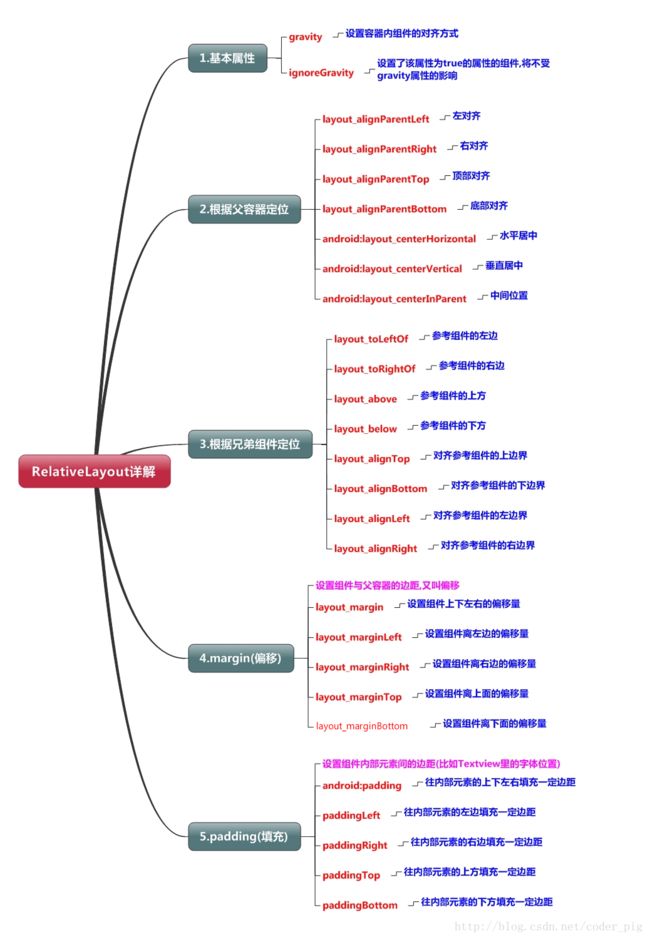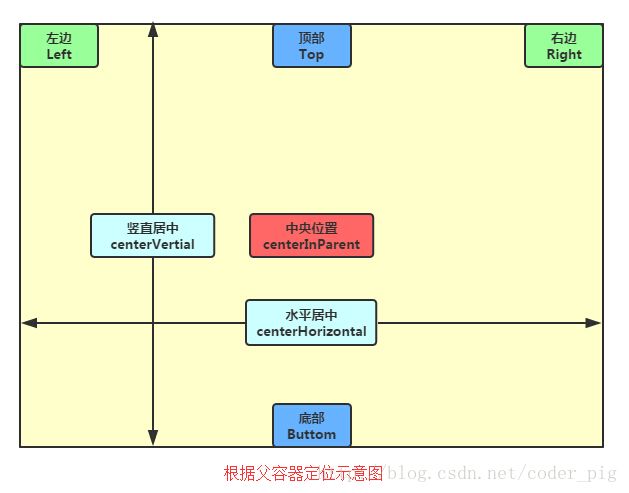当界面比较复杂的时候,嵌套多层的 LinearLayout会降低UI Render的效率(渲染速度),而且在listview或者GridView上效率会更低,太多层的LinearLayout嵌套也会占用更多的系统资源,还有可能引发stackoverflow。如果使用RelativeLayout的话,则可能仅仅需要一层就可以完成了,以父容器或者兄弟组件参考+margin +padding就可以设置组件的显示位置。总结:使用RelativeLayout + LinearLayout的weight属性搭配使用可以适用于绝大多数的布局开发。
根据父容器定位属性示意图
根据兄弟组件定位(兄弟组件就是处于同一层次容器的组件)
如果在相对布局里,控件没有指明相对位置,则默认都是在相对布局的左上角。
1、基本属性:
android:gravity 容器内组件的对齐方式
android:ignoreGravity 设置了该属性为true的组件将不受gravity的影响
2、根据父容器定位的属性:(值为true或false)
android:layout_alignParentLeft 左对齐
android:layout_alignParentRight 右对齐
android:layout_alignParentTop 顶部对齐
android:layout_alignParentBottom 底部对齐
android:layout_centerHorizontal 水平居中
android:layout_centerVertical 垂直居中
android:layout_centerInParent 位于父容器中心
3、根据兄弟组件定位的属性:(属性值必须为id的引用名“@id/id-name”)
android:layout_toLeftOf 参考组件的左边
android:layout_toRightOf 参考组件的右边
android:layout_above 参考组件的上方
android:layout_below 参考组件的下方
android:layout_alignTop 对齐参考组件的上边界
android:layout_alignBottom 对齐参考组件的下边界
android:layout_alignLeft 对齐参考组件的左边界
android:layout_alignRight 对齐参考组件的右边界
4、设置组件与父容器的边距(偏移),属性值为具体的像素值
android:layout_margin 设置组件离上下左右的偏移量
android:layout_marginLeft 设置组件离左边的偏移量
android:layout_marginRight 设置组件离右边的偏移量
android:layout_marginTop 设置组件离上边的偏移量
android:layout_marginBottom 设置组件离下边的偏移量
5、设置组件内部元素间的边距(属性值为具体的像素值)
android:padding 往内部元素上下左右填充一定边距
android:paddingLeft 往内部元素的左边填充一定边距
android:paddingRight 往内部元素的右边填充一定边距
android:paddingTop 往内部元素的上边填充一定边距
android:paddingBottom 往内部元素的下边填充一定边距


